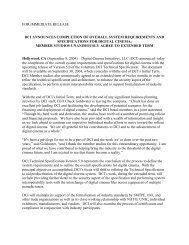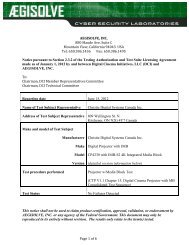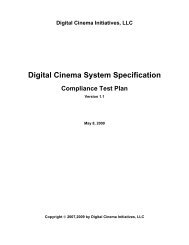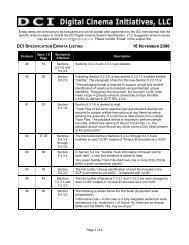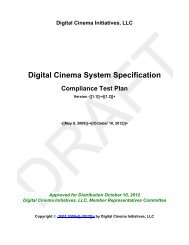DCI Specs - Digital Cinema Initiatives
DCI Specs - Digital Cinema Initiatives
DCI Specs - Digital Cinema Initiatives
Create successful ePaper yourself
Turn your PDF publications into a flip-book with our unique Google optimized e-Paper software.
equirements for encrypting the essence (sound, picture and subtitles) of the DCP.• Transport: Defines the movement from distribution centers to theater locations usingphysical media, virtual private networks or satellite communications.• Theater Systems: Provides requirements for all equipment necessary for theatricalpresentation in a typical theater environment. This encompasses digital projectors,media blocks, storage systems, sound systems, the DCP files ingest, theaterautomation, Screen Management System (SMS) and Theater Management Systems(TMS).• Projection: This section defines the projector and its controlled environment, along withthe acceptable tolerances around critical image parameters for Mastering and generalExhibition applications. The goal is to provide a means for achieving consistent andrepeatable color image quality. Two levels of tolerances are specified: a tighter tolerancefor mastering rooms where critical color judgments are made, and a wider tolerance forsatisfactory reproduction in general public exhibition.• Security: The security chapter provides requirements and fundamental specifications forpersistent content protection and controlled access in an open security architecture.These objectives are achieved with high security in a multi-user environment via theapplication of well respected security and encryption standards in primarily three areas:1) content encryption, 2) security (key) management and 3) high integrity event loggingand reporting.1.3. Document LanguageThis document consists of normative text and, optional informative text. Normative text is textthat describes the elements of the design that are indispensable or contains the conformancelanguage keywords: “shall”, “should” or “may”. Informative text is text that is potentially helpful tothe user, but not indispensable and can be removed, changed or added editorially withoutaffecting interoperability. Informative text does not contain any conformance keywords. All textin the document is, by default, normative except: any section titled “Introduction”, any sectionexplicitly labeled as “Informative”, or individual paragraphs that start with the word “Note.”Normative references are those external documents referenced in normative text and areindispensable to the user. Informative, or bibliographic, references are those references madefrom informative text or are otherwise not indispensable to the user.The keywords “shall” and “shall not” indicate requirements that must be strictly followed in orderto conform to the document and from which no deviation is permitted.The keywords “should” and “should not” indicate that among several possibilities one isrecommended as particularly suitable, without mentioning or excluding others; or that a certaincourse of action is preferred but not necessarily required. In the negative form, a certainpossibility or course of action is deprecated but not prohibited.The keywords “may” and “need not” indicate a course of action permissible within the limits ofthe document.The keyword “reserved” indicates that a condition is not defined and shall have no meaning.However, it may be defined in the future. The keyword “forbidden” is the same as reserved,except that the condition shall never be defined in the future.A compliant implementation is one that includes all mandatory provisions (“shall”) and, ifimplemented, all recommended provisions (“should”) as described. A compliant implementationneed not implement optional provisions (“may”).<strong>DCI</strong> <strong>Digital</strong> <strong>Cinema</strong> System Specification v.1.2 Page 16




